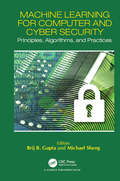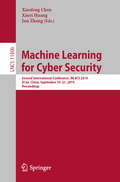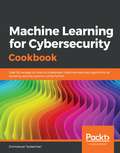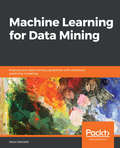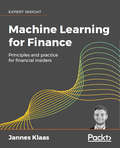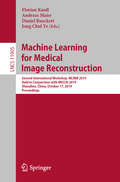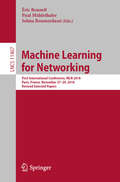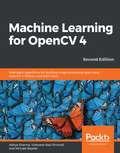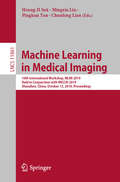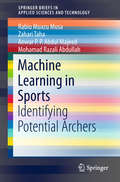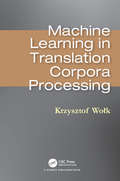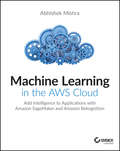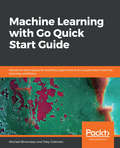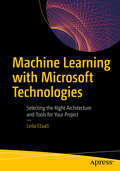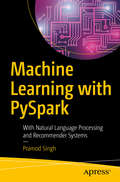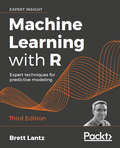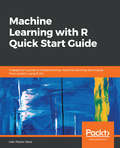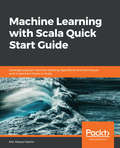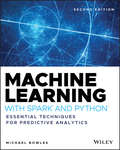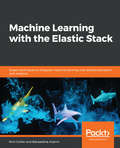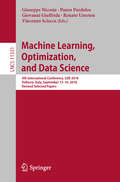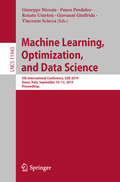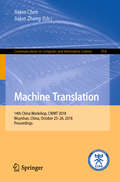- Table View
- List View
Machine Learning for Computer and Cyber Security: Principle, Algorithms, and Practices (Cyber Ecosystem And Security Ser.)
by Quan Z. Sheng Brij B. GuptaWhile Computer Security is a broader term which incorporates technologies, protocols, standards and policies to ensure the security of the computing systems including the computer hardware, software and the information stored in it, Cyber Security is a specific, growing field to protect computer networks (offline and online) from unauthorized access, botnets, phishing scams, etc. Machine learning is a branch of Computer Science which enables computing machines to adopt new behaviors on the basis of observable and verifiable data and information. It can be applied to ensure the security of the computers and the information by detecting anomalies using data mining and other such techniques. <P><P>This book will be an invaluable resource to understand the importance of machine learning and data mining in establishing computer and cyber security. It emphasizes important security aspects associated with computer and cyber security along with the analysis of machine learning and data mining based solutions. The book also highlights the future research domains in which these solutions can be applied. Furthermore, it caters to the needs of IT professionals, researchers, faculty members, scientists, graduate students, research scholars and software developers who seek to carry out research and develop combating solutions in the area of cyber security using machine learning based approaches. It is an extensive source of information for the readers belonging to the field of Computer Science and Engineering, and Cyber Security professionals. <P><P>Key Features: <li>This book contains examples and illustrations to demonstrate the principles, algorithms, challenges and applications of machine learning and data mining for computer and cyber security. <li>It showcases important security aspects and current trends in the field. <li>It provides an insight of the future research directions in the field. <P><P>Contents of this book help to prepare the students for exercising better defense in terms of understanding the motivation of the attackers and how to deal with and mitigate the situation using machine learning based approaches in better manner.
Machine Learning for Cyber Security: Second International Conference, ML4CS 2019, Xi’an, China, September 19-21, 2019, Proceedings (Lecture Notes in Computer Science #11806)
by Jun Zhang Xinyi Huang Xiaofeng ChenThis book constitutes the proceedings of the Second International Conference on Machine Learning for Cyber Security, ML4CS 2019, held in Xi’an, China in September 2019. The 23 revised full papers and 3 short papers presented were carefully reviewed and selected from 70 submissions. The papers detail all aspects of machine learning in network infrastructure security, in network security detections and in application software security.
Machine Learning for Cybersecurity Cookbook: Over 80 recipes on how to implement machine learning algorithms for building security systems using Python
by Emmanuel TsukermanLearn how to apply modern AI to create powerful cybersecurity solutions for malware, pentesting, social engineering, data privacy, and intrusion detection Key Features Manage data of varying complexity to protect your system using the Python ecosystem Apply ML to pentesting, malware, data privacy, intrusion detection system(IDS) and social engineering Automate your daily workflow by addressing various security challenges using the recipes covered in the book Book Description Organizations today face a major threat in terms of cybersecurity, from malicious URLs to credential reuse, and having robust security systems can make all the difference. With this book, you'll learn how to use Python libraries such as TensorFlow and scikit-learn to implement the latest artificial intelligence (AI) techniques and handle challenges faced by cybersecurity researchers. You'll begin by exploring various machine learning (ML) techniques and tips for setting up a secure lab environment. Next, you'll implement key ML algorithms such as clustering, gradient boosting, random forest, and XGBoost. The book will guide you through constructing classifiers and features for malware, which you'll train and test on real samples. As you progress, you'll build self-learning, reliant systems to handle cybersecurity tasks such as identifying malicious URLs, spam email detection, intrusion detection, network protection, and tracking user and process behavior. Later, you'll apply generative adversarial networks (GANs) and autoencoders to advanced security tasks. Finally, you'll delve into secure and private AI to protect the privacy rights of consumers using your ML models. By the end of this book, you'll have the skills you need to tackle real-world problems faced in the cybersecurity domain using a recipe-based approach. What you will learn Learn how to build malware classifiers to detect suspicious activities Apply ML to generate custom malware to pentest your security Use ML algorithms with complex datasets to implement cybersecurity concepts Create neural networks to identify fake videos and images Secure your organization from one of the most popular threats – insider threats Defend against zero-day threats by constructing an anomaly detection system Detect web vulnerabilities effectively by combining Metasploit and ML Understand how to train a model without exposing the training data Who this book is for This book is for cybersecurity professionals and security researchers who are looking to implement the latest machine learning techniques to boost computer security, and gain insights into securing an organization using red and blue team ML. This recipe-based book will also be useful for data scientists and machine learning developers who want to experiment with smart techniques in the cybersecurity domain. Working knowledge of Python programming and familiarity with cybersecurity fundamentals will help you get the most out of this book.
Machine Learning for Data Mining: Improve your data mining capabilities with advanced predictive modeling
by Jesus SalcedoGet efficient in performing data mining and machine learning using IBM SPSS Modeler Key FeaturesLearn how to apply machine learning techniques in the field of data scienceUnderstand when to use different data mining techniques, how to set up different analyses, and how to interpret the resultsA step-by-step approach to improving model development and performanceBook DescriptionMachine learning (ML) combined with data mining can give you amazing results in your data mining work by empowering you with several ways to look at data. This book will help you improve your data mining techniques by using smart modeling techniques.This book will teach you how to implement ML algorithms and techniques in your data mining work. It will enable you to pair the best algorithms with the right tools and processes. You will learn how to identify patterns and make predictions with minimal human intervention. You will build different types of ML models, such as the neural network, the Support Vector Machines (SVMs), and the Decision tree. You will see how all of these models works and what kind of data in the dataset they are suited for. You will learn how to combine the results of different models in order to improve accuracy. Topics such as removing noise and handling errors will give you an added edge in model building and optimization.By the end of this book, you will be able to build predictive models and extract information of interest from the datasetWhat you will learnHone your model-building skills and create the most accurate modelsUnderstand how predictive machine learning models workPrepare your data to acquire the best possible resultsCombine models in order to suit the requirements of different types of dataAnalyze single and multiple models and understand their combined resultsDerive worthwhile insights from your data using histograms and graphsWho this book is forIf you are a data scientist, data analyst, and data mining professional and are keen to achieve a 30% higher salary by adding machine learning to your skillset, then this is the ideal book for you. You will learn to apply machine learning techniques to various data mining challenges. No prior knowledge of machine learning is assumed.
Machine Learning for Finance: The practical guide to using data-driven algorithms in banking, insurance, and investments
by Jannes KlaasPlan and build useful machine learning systems for financial services, with full working Python codeKey FeaturesBuild machine learning systems that will be useful across the financial services industryDiscover how machine learning can solve finance industry challengesGain the machine learning insights and skills fintech companies value mostBook DescriptionMachine learning skills are essential for anybody working in financial data analysis. Machine Learning for Finance shows you how to build machine learning models for use in financial services organizations. It shows you how to work with all the key machine learning models, from simple regression to advanced neural networks.You will see how to use machine learning to automate manual tasks, identify and address systemic bias, and find new insights and patterns hidden in available data. Machine Learning for Finance encourages and equips you to find new ways to use data to serve an organization’s business goals.Broad in scope yet deeply practical in approach, Machine Learning for Finance will help you to apply machine learning in all parts of a financial organization’s infrastructure. If you work or plan to work in fintech, and want to gain one of the most valuable skills in the sector today, this book is for you.What you will learnPractical machine learning for the finance sectorBuild machine learning systems that support the goals of financial organizationsThink creatively about problems and how machine learning can solve themIdentify and reduce sources of bias from machine learning modelsApply machine learning to structured data, natural language, photographs, and written text related to financeUse machine learning to detect fraud, forecast financial trends, analyze customer sentiments, and moreImplement heuristic baselines, time series, generative models, and reinforcement learning in Python, scikit-learn, Keras, and TensorFlowWho this book is forMachine Learning for Finance is for financial professionals who want to develop and apply machine learning skills, and for students entering the field. You should be comfortable with Python and the basic data science stack, such as NumPy, pandas, and Matplotlib, to get the most out of this book.
Machine Learning for Medical Image Reconstruction: Second International Workshop, MLMIR 2019, Held in Conjunction with MICCAI 2019, Shenzhen, China, October 17, 2019, Proceedings (Lecture Notes in Computer Science #11905)
by Daniel Rueckert Andreas Maier Florian Knoll Jong Chul YeThis book constitutes the refereed proceedings of the Second International Workshop on Machine Learning for Medical Reconstruction, MLMIR 2019, held in conjunction with MICCAI 2019, in Shenzhen, China, in October 2019. The 24 full papers presented were carefully reviewed and selected from 32 submissions. The papers are organized in the following topical sections: deep learning for magnetic resonance imaging; deep learning for computed tomography; and deep learning for general image reconstruction.
Machine Learning for Networking: First International Conference, MLN 2018, Paris, France, November 27–29, 2018, Revised Selected Papers (Lecture Notes in Computer Science #11407)
by Selma Boumerdassi Éric Renault Paul MühlethalerThis book constitutes the thoroughly refereed proceedings of the First International Conference on Machine Learning for Networking, MLN 2018, held in Paris, France, in November 2018. The 22 revised full papers included in the volume were carefully reviewed and selected from 48 submissions. They present new trends in the following topics: Deep and reinforcement learning; Pattern recognition and classification for networks; Machine learning for network slicing optimization, 5G system, user behavior prediction, multimedia, IoT, security and protection; Optimization and new innovative machine learning methods; Performance analysis of machine learning algorithms; Experimental evaluations of machine learning; Data mining in heterogeneous networks; Distributed and decentralized machine learning algorithms; Intelligent cloud-support communications, resource allocation, energy-aware/green communications, software defined networks, cooperative networks, positioning and navigation systems, wireless communications, wireless sensor networks, underwater sensor networks.
Machine Learning for OpenCV 4: Intelligent algorithms for building image processing apps using OpenCV 4, Python, and scikit-learn, 2nd Edition
by Michael Beyeler Aditya Sharma Vishwesh Ravi ShrimaliA practical guide to understanding the core machine learning and deep learning algorithms, and implementing them to create intelligent image processing systems using OpenCV 4 Key Features Gain insights into machine learning algorithms, and implement them using OpenCV 4 and scikit-learn Get up to speed with Intel OpenVINO and its integration with OpenCV 4 Implement high-performance machine learning models with helpful tips and best practices Book Description OpenCV is an opensource library for building computer vision apps. The latest release, OpenCV 4, offers a plethora of features and platform improvements that are covered comprehensively in this up-to-date second edition. You'll start by understanding the new features and setting up OpenCV 4 to build your computer vision applications. You will explore the fundamentals of machine learning and even learn to design different algorithms that can be used for image processing. Gradually, the book will take you through supervised and unsupervised machine learning. You will gain hands-on experience using scikit-learn in Python for a variety of machine learning applications. Later chapters will focus on different machine learning algorithms, such as a decision tree, support vector machines (SVM), and Bayesian learning, and how they can be used for object detection computer vision operations. You will then delve into deep learning and ensemble learning, and discover their real-world applications, such as handwritten digit classification and gesture recognition. Finally, you'll get to grips with the latest Intel OpenVINO for building an image processing system. By the end of this book, you will have developed the skills you need to use machine learning for building intelligent computer vision applications with OpenCV 4. What you will learn Understand the core machine learning concepts for image processing Explore the theory behind machine learning and deep learning algorithm design Discover effective techniques to train your deep learning models Evaluate machine learning models to improve the performance of your models Integrate algorithms such as support vector machines and Bayes classifier in your computer vision applications Use OpenVINO with OpenCV 4 to speed up model inference Who this book is for This book is for Computer Vision professionals, machine learning developers, or anyone who wants to learn machine learning algorithms and implement them using OpenCV 4. If you want to build real-world Computer Vision and image processing applications powered by machine learning, then this book is for you. Working knowledge of Python programming is required to get the most out of this book.
Machine Learning in Medical Imaging: 10th International Workshop, MLMI 2019, Held in Conjunction with MICCAI 2019, Shenzhen, China, October 13, 2019, Proceedings (Lecture Notes in Computer Science #11861)
by Heung-Il Suk Mingxia Liu Pingkun Yan Chunfeng LianThis book constitutes the proceedings of the 10th International Workshop on Machine Learning in Medical Imaging, MLMI 2019, held in conjunction with MICCAI 2019, in Shenzhen, China, in October 2019. The 78 papers presented in this volume were carefully reviewed and selected from 158 submissions. They focus on major trends and challenges in the area, aiming to identify new-cutting-edge techniques and their uses in medical imaging. Topics dealt with are: deep learning, generative adversarial learning, ensemble learning, sparse learning, multi-task learning, multi-view learning, manifold learning, and reinforcement learning, with their applications to medical image analysis, computer-aided detection and diagnosis, multi-modality fusion, image reconstruction, image retrieval, cellular image analysis, molecular imaging, digital pathology, etc.
Machine Learning in Sports: Identifying Potential Archers (SpringerBriefs in Applied Sciences and Technology)
by Zahari Taha Rabiu Muazu Musa Mohamad Razali Abdullah Anwar P.P.Abdul MajeedThis brief highlights the association of different performance variables that influences archery performance and the employment of different machine learning algorithms in the identification of potential archers. The sport of archery is often associated with a myriad of performance indicators namely bio-physiological, psychological, anthropometric as well as physical fitness. Traditionally, the determination of potential archers is carried out by means of conventional statistical techniques. Nonetheless, such methods often fall short in associating non-linear relationships between the variables. This book explores the notion of machine learning that is capable of mitigating the aforesaid issue. This book is valuable for coaches and managers in identifying potential archers during talent identification programs.
Machine Learning in Translation Corpora Processing
by Krzysztof WolkThis book reviews ways to improve statistical machine speech translation between Polish and English. Research has been conducted mostly on dictionary-based, rule-based, and syntax-based, machine translation techniques. Most popular methodologies and tools are not well-suited for the Polish language and therefore require adaptation, and language resources are lacking in parallel and monolingual data. The main objective of this volume to develop an automatic and robust Polish-to-English translation system to meet specific translation requirements and to develop bilingual textual resources by mining comparable corpora.
Machine Learning in the AWS Cloud: Add Intelligence to Applications with Amazon SageMaker and Amazon Rekognition
by Abhishek MishraPut the power of AWS Cloud machine learning services to work in your business and commercial applications! Machine Learning in the AWS Cloud introduces readers to the machine learning (ML) capabilities of the Amazon Web Services ecosystem and provides practical examples to solve real-world regression and classification problems. While readers do not need prior ML experience, they are expected to have some knowledge of Python and a basic knowledge of Amazon Web Services. Part One introduces readers to fundamental machine learning concepts. You will learn about the types of ML systems, how they are used, and challenges you may face with ML solutions. Part Two focuses on machine learning services provided by Amazon Web Services. You’ll be introduced to the basics of cloud computing and AWS offerings in the cloud-based machine learning space. Then you’ll learn to use Amazon Machine Learning to solve a simpler class of machine learning problems, and Amazon SageMaker to solve more complex problems. • Learn techniques that allow you to preprocess data, basic feature engineering, visualizing data, and model building • Discover common neural network frameworks with Amazon SageMaker • Solve computer vision problems with Amazon Rekognition • Benefit from illustrations, source code examples, and sidebars in each chapter The book appeals to both Python developers and technical/solution architects. Developers will find concrete examples that show them how to perform common ML tasks with Python on AWS. Technical/solution architects will find useful information on the machine learning capabilities of the AWS ecosystem.
Machine Learning with Go Quick Start Guide: Hands-on techniques for building supervised and unsupervised machine learning workflows
by Michael Bironneau Toby ColemanThis quick start guide will bring the readers to a basic level of understanding when it comes to the Machine Learning (ML) development lifecycle, will introduce Go ML libraries and then will exemplify common ML methods such as Classification, Regression, and ClusteringKey FeaturesYour handy guide to building machine learning workflows in Go for real-world scenariosBuild predictive models using the popular supervised and unsupervised machine learning techniquesLearn all about deployment strategies and take your ML application from prototype to production readyBook DescriptionMachine learning is an essential part of today's data-driven world and is extensively used across industries, including financial forecasting, robotics, and web technology. This book will teach you how to efficiently develop machine learning applications in Go.The book starts with an introduction to machine learning and its development process, explaining the types of problems that it aims to solve and the solutions it offers. It then covers setting up a frictionless Go development environment, including running Go interactively with Jupyter notebooks. Finally, common data processing techniques are introduced.The book then teaches the reader about supervised and unsupervised learning techniques through worked examples that include the implementation of evaluation metrics. These worked examples make use of the prominent open-source libraries GoML and Gonum.The book also teaches readers how to load a pre-trained model and use it to make predictions. It then moves on to the operational side of running machine learning applications: deployment, Continuous Integration, and helpful advice for effective logging and monitoring.At the end of the book, readers will learn how to set up a machine learning project for success, formulating realistic success criteria and accurately translating business requirements into technical ones.What you will learnUnderstand the types of problem that machine learning solves, and the various approachesImport, pre-process, and explore data with Go to make it ready for machine learning algorithmsVisualize data with gonum/plot and GophernotesDiagnose common machine learning problems, such as overfitting and underfittingImplement supervised and unsupervised learning algorithms using Go librariesBuild a simple web service around a model and use it to make predictionsWho this book is forThis book is for developers and data scientists with at least beginner-level knowledge of Go, and a vague idea of what types of problem Machine Learning aims to tackle. No advanced knowledge of Go (and no theoretical understanding of the math that underpins Machine Learning) is required.
Machine Learning with Microsoft Technologies: Selecting the Right Architecture and Tools for Your Project
by Leila EtaatiKnow how to do machine learning with Microsoft technologies. This book teaches you to do predictive, descriptive, and prescriptive analyses with Microsoft Power BI, Azure Data Lake, SQL Server, Stream Analytics, Azure Databricks, HD Insight, and more.The ability to analyze massive amounts of real-time data and predict future behavior of an organization is critical to its long-term success. Data science, and more specifically machine learning (ML), is today’s game changer and should be a key building block in every company’s strategy. Managing a machine learning process from business understanding, data acquisition and cleaning, modeling, and deployment in each tool is a valuable skill set. Machine Learning with Microsoft Technologies is a demo-driven book that explains how to do machine learning with Microsoft technologies. You will gain valuable insight into designing the best architecture for development, sharing, and deploying a machine learning solution. This book simplifies the process of choosing the right architecture and tools for doing machine learning based on your specific infrastructure needs and requirements. Detailed content is provided on the main algorithms for supervised and unsupervised machine learning and examples show ML practices using both R and Python languages, the main languages inside Microsoft technologies. What You'll Learn Choose the right Microsoft product for your machine learning solutionCreate and manage Microsoft’s tool environments for development, testing, and production of a machine learning projectImplement and deploy supervised and unsupervised learning in Microsoft products Set up Microsoft Power BI, Azure Data Lake, SQL Server, Stream Analytics, Azure Databricks, and HD Insight to perform machine learning Set up a data science virtual machine and test-drive installed tools, such as Azure ML Workbench, Azure ML Server Developer, Anaconda Python, Jupyter Notebook, Power BI Desktop, Cognitive Services, machine learning and data analytics tools, and more Architect a machine learning solution factoring in all aspects of self service, enterprise, deployment, and sharingWho This Book Is ForData scientists, data analysts, developers, architects, and managers who want to leverage machine learning in their products, organization, and services, and make educated, cost-saving decisions about their ML architecture and tool set.
Machine Learning with PySpark: With Natural Language Processing And Recommender Systems
by Pramod SinghBuild machine learning models, natural language processing applications, and recommender systems with PySpark to solve various business challenges. This book starts with the fundamentals of Spark and its evolution and then covers the entire spectrum of traditional machine learning algorithms along with natural language processing and recommender systems using PySpark. Machine Learning with PySpark shows you how to build supervised machine learning models such as linear regression, logistic regression, decision trees, and random forest. You’ll also see unsupervised machine learning models such as K-means and hierarchical clustering. A major portion of the book focuses on feature engineering to create useful features with PySpark to train the machine learning models. The natural language processing section covers text processing, text mining, and embedding for classification. After reading this book, you will understand how to use PySpark’s machine learning library to build and train various machine learning models. Additionally you’ll become comfortable with related PySpark components, such as data ingestion, data processing, and data analysis, that you can use to develop data-driven intelligent applications.What You Will LearnBuild a spectrum of supervised and unsupervised machine learning algorithmsImplement machine learning algorithms with Spark MLlib librariesDevelop a recommender system with Spark MLlib librariesHandle issues related to feature engineering, class balance, bias and variance, and cross validation for building an optimal fit modelWho This Book Is For Data science and machine learning professionals.
Machine Learning with R - Third Edition
by Brett LantzData scientists, students, and other practitioners who want a clear, accessible guide to machine learning with R.
Machine Learning with R Quick Start Guide: A beginner's guide to implementing machine learning techniques from scratch using R 3.5
by Ivan Pastor SanzLearn how to use R to apply powerful machine learning methods and gain insight into real-world applications using clustering, logistic regressions, random forests, support vector machine, and more. Key Features Use R 3.5 to implement real-world examples in machine learning Implement key machine learning algorithms to understand the working mechanism of smart models Create end-to-end machine learning pipelines using modern libraries from the R ecosystem Book Description Machine Learning with R Quick Start Guide takes you on a data-driven journey that starts with the very basics of R and machine learning. It gradually builds upon core concepts so you can handle the varied complexities of data and understand each stage of the machine learning pipeline. From data collection to implementing Natural Language Processing (NLP), this book covers it all. You will implement key machine learning algorithms to understand how they are used to build smart models. You will cover tasks such as clustering, logistic regressions, random forests, support vector machines, and more. Furthermore, you will also look at more advanced aspects such as training neural networks and topic modeling. By the end of the book, you will be able to apply the concepts of machine learning, deal with data-related problems, and solve them using the powerful yet simple language that is R. What you will learn Introduce yourself to the basics of machine learning with R 3.5 Get to grips with R techniques for cleaning and preparing your data for analysis and visualize your results Learn to build predictive models with the help of various machine learning techniques Use R to visualize data spread across multiple dimensions and extract useful features Use interactive data analysis with R to get insights into data Implement supervised and unsupervised learning, and NLP using R libraries Who this book is for This book is for graduate students, aspiring data scientists, and data analysts who wish to enter the field of machine learning and are looking to implement machine learning techniques and methodologies from scratch using R 3.5. A working knowledge of the R programming language is expected.
Machine Learning with R: Expert techniques for predictive modeling, 3rd Edition
by Brett LantzSolve real-world data problems with R and machine learningKey FeaturesThird edition of the bestselling, widely acclaimed R machine learning book, updated and improved for R 3.6 and beyondHarness the power of R to build flexible, effective, and transparent machine learning modelsLearn quickly with a clear, hands-on guide by experienced machine learning teacher and practitioner, Brett LantzBook DescriptionMachine learning, at its core, is concerned with transforming data into actionable knowledge. R offers a powerful set of machine learning methods to quickly and easily gain insight from your data.Machine Learning with R, Third Edition provides a hands-on, readable guide to applying machine learning to real-world problems. Whether you are an experienced R user or new to the language, Brett Lantz teaches you everything you need to uncover key insights, make new predictions, and visualize your findings.This new 3rd edition updates the classic R data science book to R 3.6 with newer and better libraries, advice on ethical and bias issues in machine learning, and an introduction to deep learning. Find powerful new insights in your data; discover machine learning with R.What you will learnDiscover the origins of machine learning and how exactly a computer learns by examplePrepare your data for machine learning work with the R programming languageClassify important outcomes using nearest neighbor and Bayesian methodsPredict future events using decision trees, rules, and support vector machinesForecast numeric data and estimate financial values using regression methodsModel complex processes with artificial neural networks — the basis of deep learningAvoid bias in machine learning modelsEvaluate your models and improve their performanceConnect R to SQL databases and emerging big data technologies such as Spark, H2O, and TensorFlowWho this book is forData scientists, students, and other practitioners who want a clear, accessible guide to machine learning with R.
Machine Learning with Scala Quick Start Guide: Leverage popular machine learning algorithms and techniques and implement them in Scala
by Md. Rezaul KarimSupervised and unsupervised machine learning made easy in Scala with this quick-start guide.Key FeaturesConstruct and deploy machine learning systems that learn from your data and give accurate predictionsUnleash the power of Spark ML along with popular machine learning algorithms to solve complex tasks in Scala.Solve hands-on problems by combining popular neural network architectures such as LSTM and CNN using Scala with DeepLearning4j libraryBook DescriptionScala is a highly scalable integration of object-oriented nature and functional programming concepts that make it easy to build scalable and complex big data applications. This book is a handy guide for machine learning developers and data scientists who want to develop and train effective machine learning models in Scala.The book starts with an introduction to machine learning, while covering deep learning and machine learning basics. It then explains how to use Scala-based ML libraries to solve classification and regression problems using linear regression, generalized linear regression, logistic regression, support vector machine, and Naïve Bayes algorithms.It also covers tree-based ensemble techniques for solving both classification and regression problems. Moving ahead, it covers unsupervised learning techniques, such as dimensionality reduction, clustering, and recommender systems. Finally, it provides a brief overview of deep learning using a real-life example in Scala.What you will learnGet acquainted with JVM-based machine learning libraries for Scala such as Spark ML and Deeplearning4jLearn RDDs, DataFrame, and Spark SQL for analyzing structured and unstructured dataUnderstand supervised and unsupervised learning techniques with best practices and pitfallsLearn classification and regression analysis with linear regression, logistic regression, Naïve Bayes, support vector machine, and tree-based ensemble techniques Learn effective ways of clustering analysis with dimensionality reduction techniquesLearn recommender systems with collaborative filtering approachDelve into deep learning and neural network architecturesWho this book is forThis book is for machine learning developers looking to train machine learning models in Scala without spending too much time and effort. Some fundamental knowledge of Scala programming and some basics of statistics and linear algebra is all you need to get started with this book.
Machine Learning with Spark and Python: Essential Techniques for Predictive Analytics
by Michael BowlesMachine Learning with Spark and Python Essential Techniques for Predictive Analytics, Second Edition simplifies ML for practical uses by focusing on two key algorithms. This new second edition improves with the addition of Spark—a ML framework from the Apache foundation. By implementing Spark, machine learning students can easily process much large data sets and call the spark algorithms using ordinary Python code. Machine Learning with Spark and Python focuses on two algorithm families (linear methods and ensemble methods) that effectively predict outcomes. This type of problem covers many use cases such as what ad to place on a web page, predicting prices in securities markets, or detecting credit card fraud. The focus on two families gives enough room for full descriptions of the mechanisms at work in the algorithms. Then the code examples serve to illustrate the workings of the machinery with specific hackable code.
Machine Learning with the Elastic Stack: Expert techniques to integrate machine learning with distributed search and analytics
by Bahaaldine Azarmi Rich CollierLeverage Elastic Stack's machine learning features to gain valuable insight from your data Key Features Combine machine learning with the analytic capabilities of Elastic Stack Analyze large volumes of search data and gain actionable insight from them Use external analytical tools with your Elastic Stack to improve its performance Book Description Machine Learning with the Elastic Stack is a comprehensive overview of the embedded commercial features of anomaly detection and forecasting. The book starts with installing and setting up Elastic Stack. You will perform time series analysis on varied kinds of data, such as log files, network flows, application metrics, and financial data. As you progress through the chapters, you will deploy machine learning within the Elastic Stack for logging, security, and metrics. In the concluding chapters, you will see how machine learning jobs can be automatically distributed and managed across the Elasticsearch cluster and made resilient to failure. By the end of this book, you will understand the performance aspects of incorporating machine learning within the Elastic ecosystem and create anomaly detection jobs and view results from Kibana directly. What you will learn Install the Elastic Stack to use machine learning features Understand how Elastic machine learning is used to detect a variety of anomaly types Apply effective anomaly detection to IT operations and security analytics Leverage the output of Elastic machine learning in custom views, dashboards, and proactive alerting Combine your created jobs to correlate anomalies of different layers of infrastructure Learn various tips and tricks to get the most out of Elastic machine learning Who this book is for If you are a data professional eager to gain insight on Elasticsearch data without having to rely on a machine learning specialist or custom development, Machine Learning with the Elastic Stack is for you. Those looking to integrate machine learning within their search and analytics applications will also find this book very useful. Prior experience with the Elastic Stack is needed to get the most out of this book.
Machine Learning, Optimization, and Data Science: 4th International Conference, LOD 2018, Volterra, Italy, September 13-16, 2018, Revised Selected Papers (Lecture Notes in Computer Science #11331)
by Panos Pardalos Giuseppe Nicosia Giovanni Giuffrida Renato Umeton Vincenzo SciaccaThis book constitutes the post-conference proceedings of the 4th International Conference on Machine Learning, Optimization, and Data Science, LOD 2018, held in Volterra, Italy, in September 2018.The 46 full papers presented were carefully reviewed and selected from 126 submissions. The papers cover topics in the field of machine learning, artificial intelligence, reinforcement learning, computational optimization and data science presenting a substantial array of ideas, technologies, algorithms, methods and applications.
Machine Learning, Optimization, and Data Science: 5th International Conference, LOD 2019, Siena, Italy, September 10–13, 2019, Proceedings (Lecture Notes in Computer Science #11943)
by Panos Pardalos Giuseppe Nicosia Giovanni Giuffrida Renato Umeton Vincenzo SciaccaThis book constitutes the post-conference proceedings of the 5th International Conference on Machine Learning, Optimization, and Data Science, LOD 2019, held in Siena, Italy, in September 2019. The 54 full papers presented were carefully reviewed and selected from 158 submissions. The papers cover topics in the field of machine learning, artificial intelligence, reinforcement learning, computational optimization and data science presenting a substantial array of ideas, technologies, algorithms, methods and applications.
Machine Learning: A First Course for Engineers and Scientists (Foundations And Trends In Machine Learning Ser.)
by Andreas Lindholm Niklas Wahlström Fredrik Lindsten Thomas B. SchönThis book introduces machine learning for readers with some background in basic linear algebra, statistics, probability, and programming. In a coherent statistical framework it covers a selection of supervised machine learning methods, from the most fundamental (k-NN, decision trees, linear and logistic regression) to more advanced methods (deep neural networks, support vector machines, Gaussian processes, random forests and boosting), plus commonly-used unsupervised methods (generative modeling, k-means, PCA, autoencoders and generative adversarial networks). Careful explanations and pseudo-code are presented for all methods. The authors maintain a focus on the fundamentals by drawing connections between methods and discussing general concepts such as loss functions, maximum likelihood, the bias-variance decomposition, ensemble averaging, kernels and the Bayesian approach along with generally useful tools such as regularization, cross validation, evaluation metrics and optimization methods. The final chapters offer practical advice for solving real-world supervised machine learning problems and on ethical aspects of modern machine learning.
Machine Translation: 14th China Workshop, Cwmt 2018, Wuyishan, China, October 25-26, 2018, Proceedings (Communications in Computer and Information Science #954)
by Jiajun Chen Jiajun ZhangThis book constitutes the refereed proceedings of the 14th China Workshop on Machine Translation, CWMT 2018, held in Wuyishan, China, in October 2018. The 9 papers presented in this volume were carefully reviewed and selected from 17 submissions and focus on all aspects of machine translation, including preprocessing, neural machine translation models, hybrid model, evaluation method, and post-editing.
